Higher Education: Reflective Learning and Gibbs Cycle
VerifiedAdded on 2023/06/10
|8
|1888
|351
Report
AI Summary
This report delves into the concept of reflective learning, emphasizing its importance in higher education for enhancing students' academic performance. It provides an in-depth analysis of the Gibbs reflective cycle, a framework designed to facilitate learning from experiences. The report explores the six stages of the cycle, including description, feelings, evaluation, analysis, conclusion, and action plan, highlighting how each stage contributes to a student's ability to assess their strengths and weaknesses. Furthermore, it examines the significance of feedback and feed-forward mechanisms in improving student work and strategic planning. The report underscores how these processes, combined with the Gibbs cycle, enable students to refine their skills, improve self-awareness, and achieve systematic growth, ultimately leading to better outcomes in formative and summative assessments. Various research papers are cited to support the arguments presented, providing a comprehensive overview of reflective learning within the context of higher education.
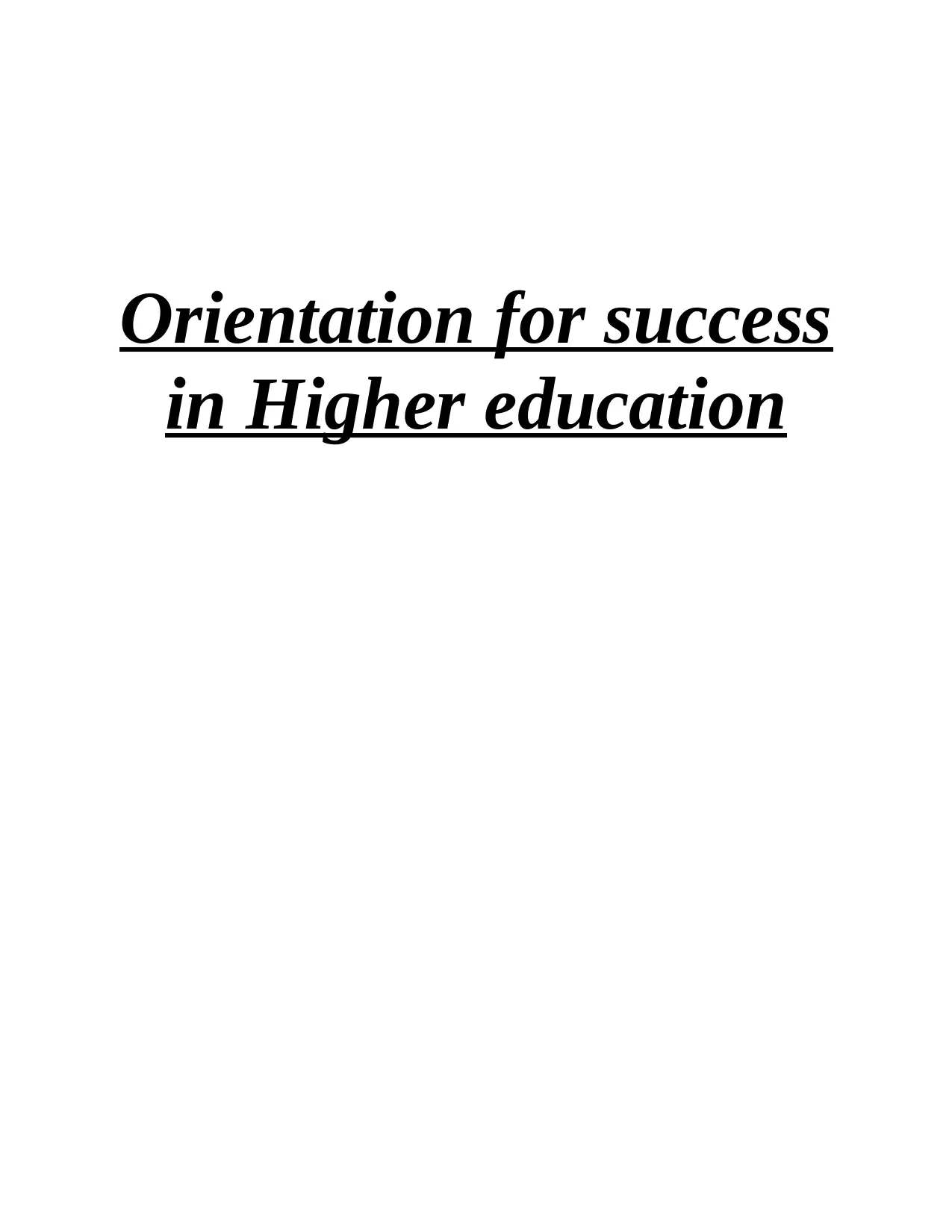
Orientation for success
in Higher education
in Higher education
Paraphrase This Document
Need a fresh take? Get an instant paraphrase of this document with our AI Paraphraser
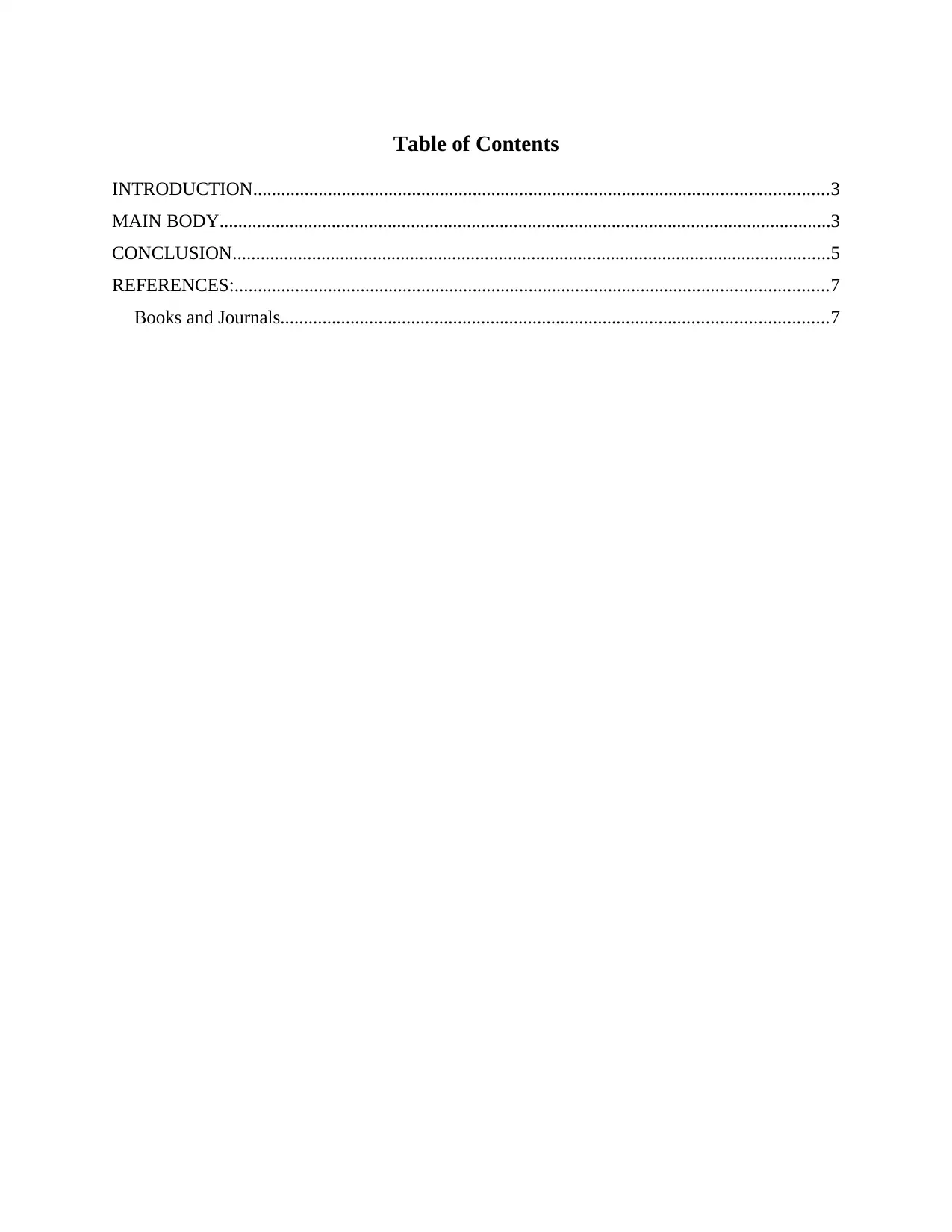
Table of Contents
INTRODUCTION...........................................................................................................................3
MAIN BODY...................................................................................................................................3
CONCLUSION................................................................................................................................5
REFERENCES:...............................................................................................................................7
Books and Journals.....................................................................................................................7
INTRODUCTION...........................................................................................................................3
MAIN BODY...................................................................................................................................3
CONCLUSION................................................................................................................................5
REFERENCES:...............................................................................................................................7
Books and Journals.....................................................................................................................7
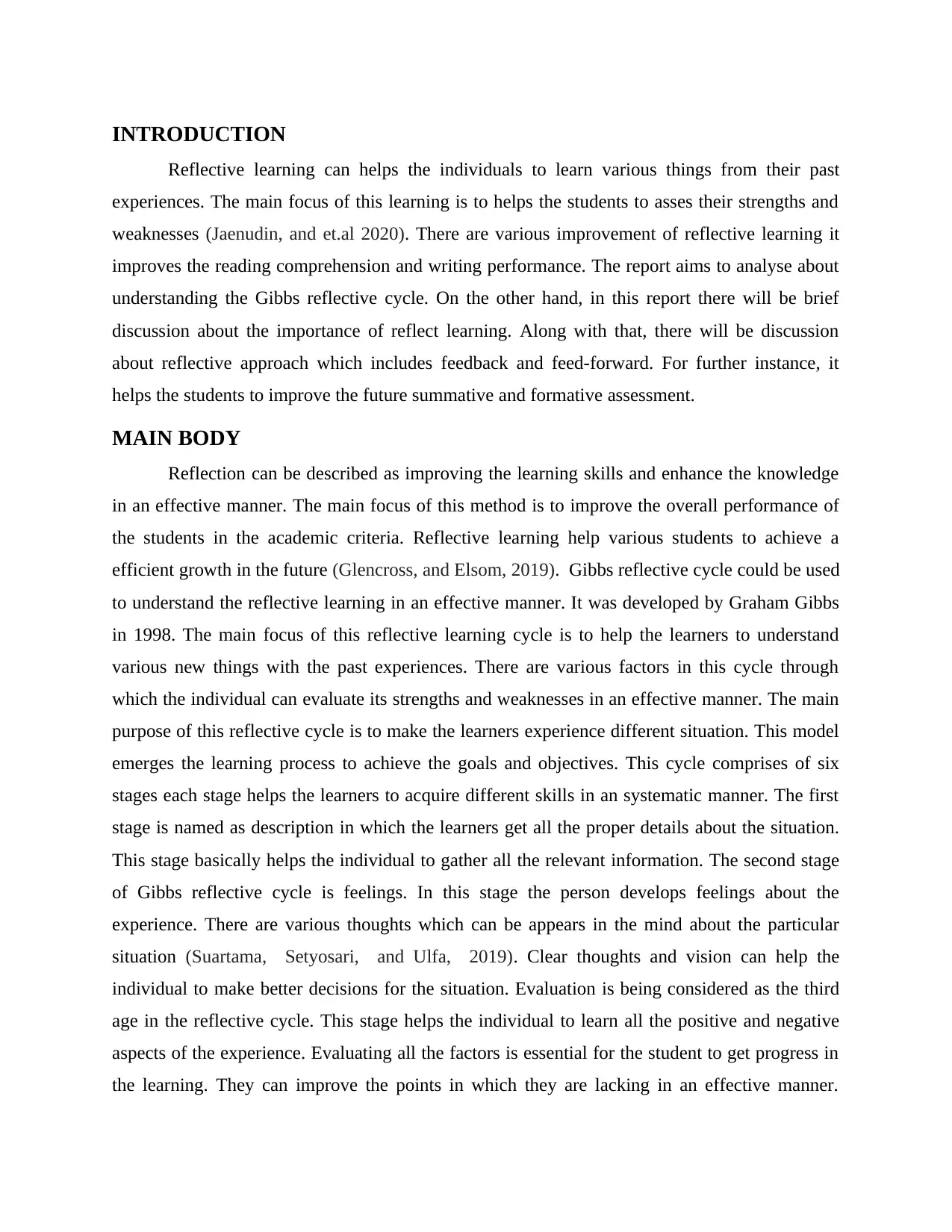
INTRODUCTION
Reflective learning can helps the individuals to learn various things from their past
experiences. The main focus of this learning is to helps the students to asses their strengths and
weaknesses (Jaenudin, and et.al 2020). There are various improvement of reflective learning it
improves the reading comprehension and writing performance. The report aims to analyse about
understanding the Gibbs reflective cycle. On the other hand, in this report there will be brief
discussion about the importance of reflect learning. Along with that, there will be discussion
about reflective approach which includes feedback and feed-forward. For further instance, it
helps the students to improve the future summative and formative assessment.
MAIN BODY
Reflection can be described as improving the learning skills and enhance the knowledge
in an effective manner. The main focus of this method is to improve the overall performance of
the students in the academic criteria. Reflective learning help various students to achieve a
efficient growth in the future (Glencross, and Elsom, 2019). Gibbs reflective cycle could be used
to understand the reflective learning in an effective manner. It was developed by Graham Gibbs
in 1998. The main focus of this reflective learning cycle is to help the learners to understand
various new things with the past experiences. There are various factors in this cycle through
which the individual can evaluate its strengths and weaknesses in an effective manner. The main
purpose of this reflective cycle is to make the learners experience different situation. This model
emerges the learning process to achieve the goals and objectives. This cycle comprises of six
stages each stage helps the learners to acquire different skills in an systematic manner. The first
stage is named as description in which the learners get all the proper details about the situation.
This stage basically helps the individual to gather all the relevant information. The second stage
of Gibbs reflective cycle is feelings. In this stage the person develops feelings about the
experience. There are various thoughts which can be appears in the mind about the particular
situation (Suartama, Setyosari, and Ulfa, 2019). Clear thoughts and vision can help the
individual to make better decisions for the situation. Evaluation is being considered as the third
age in the reflective cycle. This stage helps the individual to learn all the positive and negative
aspects of the experience. Evaluating all the factors is essential for the student to get progress in
the learning. They can improve the points in which they are lacking in an effective manner.
Reflective learning can helps the individuals to learn various things from their past
experiences. The main focus of this learning is to helps the students to asses their strengths and
weaknesses (Jaenudin, and et.al 2020). There are various improvement of reflective learning it
improves the reading comprehension and writing performance. The report aims to analyse about
understanding the Gibbs reflective cycle. On the other hand, in this report there will be brief
discussion about the importance of reflect learning. Along with that, there will be discussion
about reflective approach which includes feedback and feed-forward. For further instance, it
helps the students to improve the future summative and formative assessment.
MAIN BODY
Reflection can be described as improving the learning skills and enhance the knowledge
in an effective manner. The main focus of this method is to improve the overall performance of
the students in the academic criteria. Reflective learning help various students to achieve a
efficient growth in the future (Glencross, and Elsom, 2019). Gibbs reflective cycle could be used
to understand the reflective learning in an effective manner. It was developed by Graham Gibbs
in 1998. The main focus of this reflective learning cycle is to help the learners to understand
various new things with the past experiences. There are various factors in this cycle through
which the individual can evaluate its strengths and weaknesses in an effective manner. The main
purpose of this reflective cycle is to make the learners experience different situation. This model
emerges the learning process to achieve the goals and objectives. This cycle comprises of six
stages each stage helps the learners to acquire different skills in an systematic manner. The first
stage is named as description in which the learners get all the proper details about the situation.
This stage basically helps the individual to gather all the relevant information. The second stage
of Gibbs reflective cycle is feelings. In this stage the person develops feelings about the
experience. There are various thoughts which can be appears in the mind about the particular
situation (Suartama, Setyosari, and Ulfa, 2019). Clear thoughts and vision can help the
individual to make better decisions for the situation. Evaluation is being considered as the third
age in the reflective cycle. This stage helps the individual to learn all the positive and negative
aspects of the experience. Evaluating all the factors is essential for the student to get progress in
the learning. They can improve the points in which they are lacking in an effective manner.
⊘ This is a preview!⊘
Do you want full access?
Subscribe today to unlock all pages.

Trusted by 1+ million students worldwide
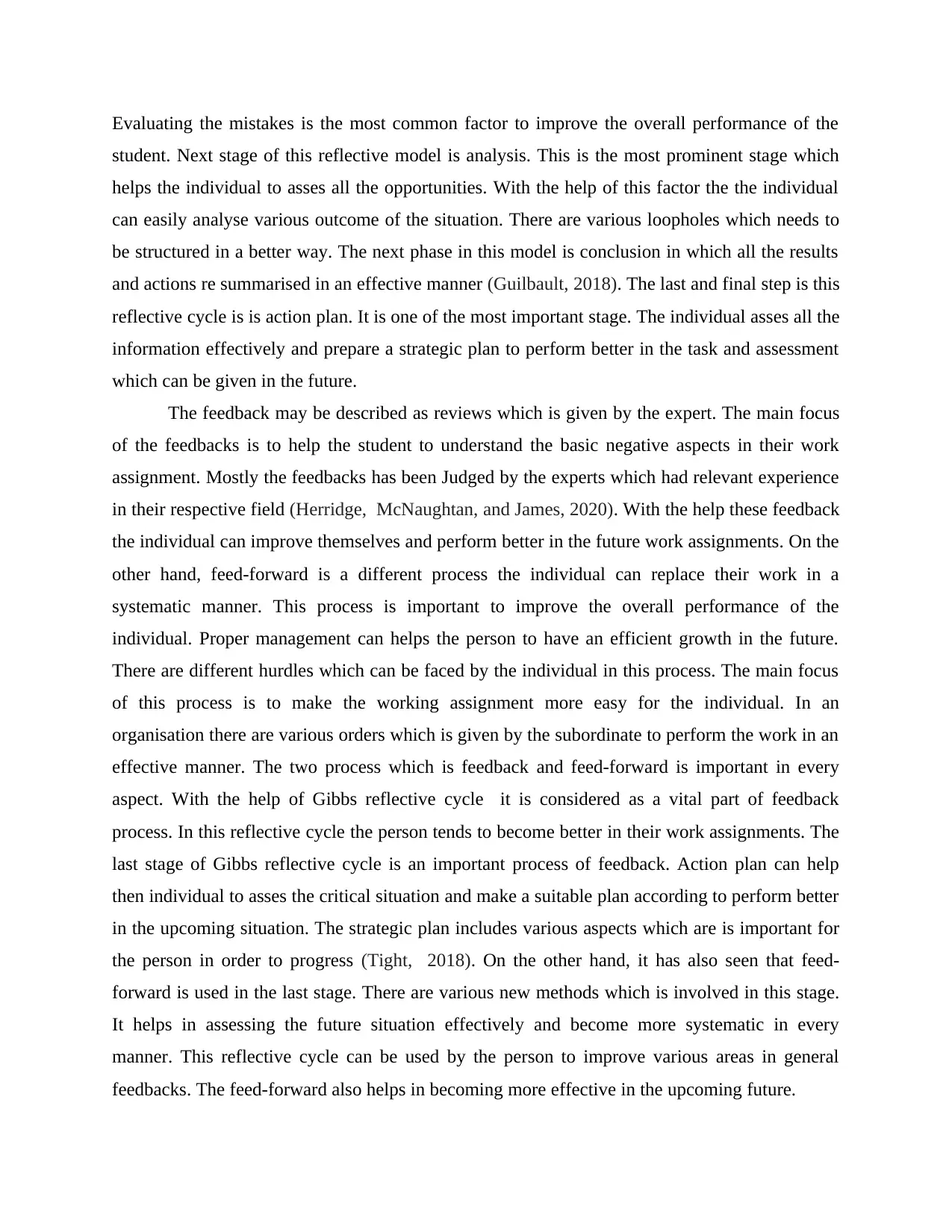
Evaluating the mistakes is the most common factor to improve the overall performance of the
student. Next stage of this reflective model is analysis. This is the most prominent stage which
helps the individual to asses all the opportunities. With the help of this factor the the individual
can easily analyse various outcome of the situation. There are various loopholes which needs to
be structured in a better way. The next phase in this model is conclusion in which all the results
and actions re summarised in an effective manner (Guilbault, 2018). The last and final step is this
reflective cycle is is action plan. It is one of the most important stage. The individual asses all the
information effectively and prepare a strategic plan to perform better in the task and assessment
which can be given in the future.
The feedback may be described as reviews which is given by the expert. The main focus
of the feedbacks is to help the student to understand the basic negative aspects in their work
assignment. Mostly the feedbacks has been Judged by the experts which had relevant experience
in their respective field (Herridge, McNaughtan, and James, 2020). With the help these feedback
the individual can improve themselves and perform better in the future work assignments. On the
other hand, feed-forward is a different process the individual can replace their work in a
systematic manner. This process is important to improve the overall performance of the
individual. Proper management can helps the person to have an efficient growth in the future.
There are different hurdles which can be faced by the individual in this process. The main focus
of this process is to make the working assignment more easy for the individual. In an
organisation there are various orders which is given by the subordinate to perform the work in an
effective manner. The two process which is feedback and feed-forward is important in every
aspect. With the help of Gibbs reflective cycle it is considered as a vital part of feedback
process. In this reflective cycle the person tends to become better in their work assignments. The
last stage of Gibbs reflective cycle is an important process of feedback. Action plan can help
then individual to asses the critical situation and make a suitable plan according to perform better
in the upcoming situation. The strategic plan includes various aspects which are is important for
the person in order to progress (Tight, 2018). On the other hand, it has also seen that feed-
forward is used in the last stage. There are various new methods which is involved in this stage.
It helps in assessing the future situation effectively and become more systematic in every
manner. This reflective cycle can be used by the person to improve various areas in general
feedbacks. The feed-forward also helps in becoming more effective in the upcoming future.
student. Next stage of this reflective model is analysis. This is the most prominent stage which
helps the individual to asses all the opportunities. With the help of this factor the the individual
can easily analyse various outcome of the situation. There are various loopholes which needs to
be structured in a better way. The next phase in this model is conclusion in which all the results
and actions re summarised in an effective manner (Guilbault, 2018). The last and final step is this
reflective cycle is is action plan. It is one of the most important stage. The individual asses all the
information effectively and prepare a strategic plan to perform better in the task and assessment
which can be given in the future.
The feedback may be described as reviews which is given by the expert. The main focus
of the feedbacks is to help the student to understand the basic negative aspects in their work
assignment. Mostly the feedbacks has been Judged by the experts which had relevant experience
in their respective field (Herridge, McNaughtan, and James, 2020). With the help these feedback
the individual can improve themselves and perform better in the future work assignments. On the
other hand, feed-forward is a different process the individual can replace their work in a
systematic manner. This process is important to improve the overall performance of the
individual. Proper management can helps the person to have an efficient growth in the future.
There are different hurdles which can be faced by the individual in this process. The main focus
of this process is to make the working assignment more easy for the individual. In an
organisation there are various orders which is given by the subordinate to perform the work in an
effective manner. The two process which is feedback and feed-forward is important in every
aspect. With the help of Gibbs reflective cycle it is considered as a vital part of feedback
process. In this reflective cycle the person tends to become better in their work assignments. The
last stage of Gibbs reflective cycle is an important process of feedback. Action plan can help
then individual to asses the critical situation and make a suitable plan according to perform better
in the upcoming situation. The strategic plan includes various aspects which are is important for
the person in order to progress (Tight, 2018). On the other hand, it has also seen that feed-
forward is used in the last stage. There are various new methods which is involved in this stage.
It helps in assessing the future situation effectively and become more systematic in every
manner. This reflective cycle can be used by the person to improve various areas in general
feedbacks. The feed-forward also helps in becoming more effective in the upcoming future.
Paraphrase This Document
Need a fresh take? Get an instant paraphrase of this document with our AI Paraphraser
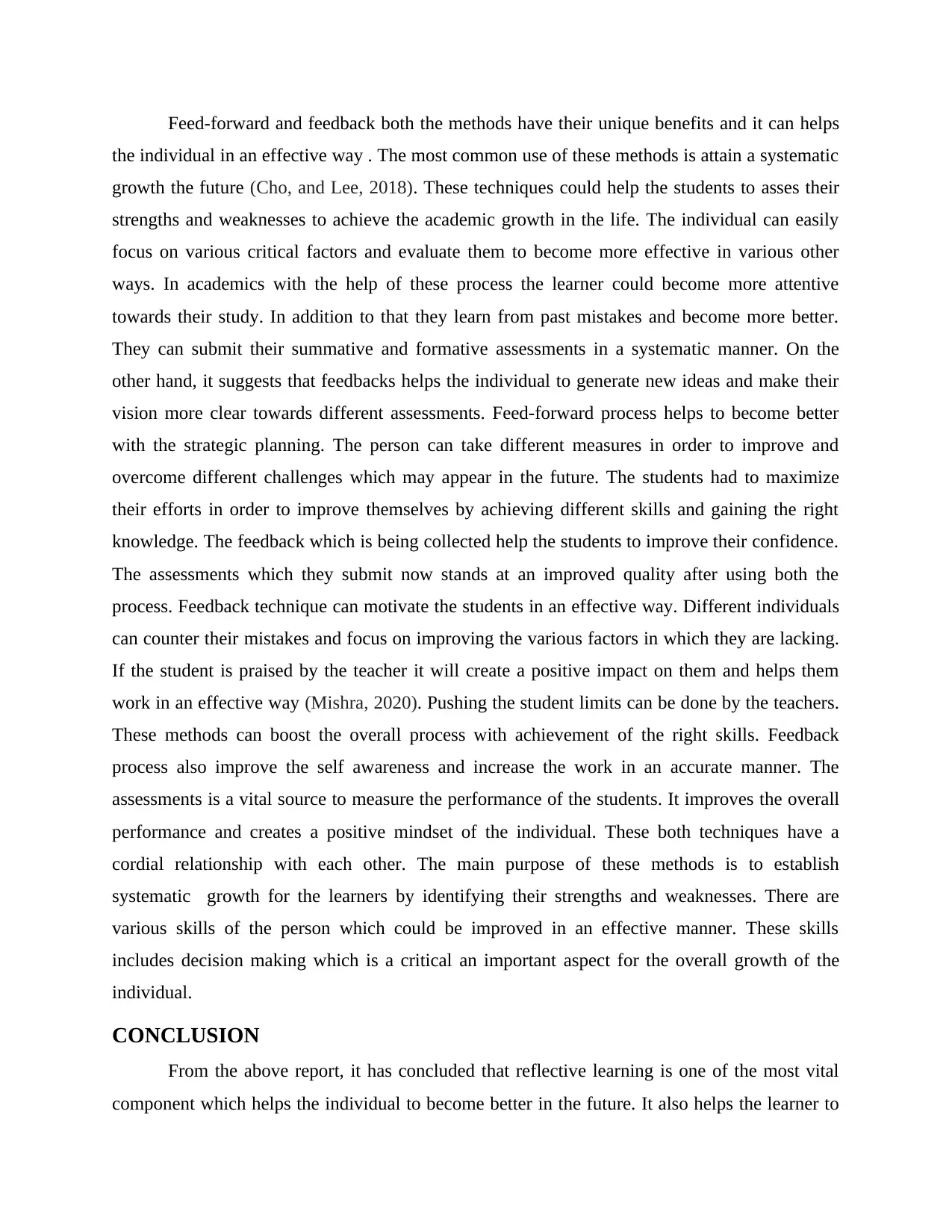
Feed-forward and feedback both the methods have their unique benefits and it can helps
the individual in an effective way . The most common use of these methods is attain a systematic
growth the future (Cho, and Lee, 2018). These techniques could help the students to asses their
strengths and weaknesses to achieve the academic growth in the life. The individual can easily
focus on various critical factors and evaluate them to become more effective in various other
ways. In academics with the help of these process the learner could become more attentive
towards their study. In addition to that they learn from past mistakes and become more better.
They can submit their summative and formative assessments in a systematic manner. On the
other hand, it suggests that feedbacks helps the individual to generate new ideas and make their
vision more clear towards different assessments. Feed-forward process helps to become better
with the strategic planning. The person can take different measures in order to improve and
overcome different challenges which may appear in the future. The students had to maximize
their efforts in order to improve themselves by achieving different skills and gaining the right
knowledge. The feedback which is being collected help the students to improve their confidence.
The assessments which they submit now stands at an improved quality after using both the
process. Feedback technique can motivate the students in an effective way. Different individuals
can counter their mistakes and focus on improving the various factors in which they are lacking.
If the student is praised by the teacher it will create a positive impact on them and helps them
work in an effective way (Mishra, 2020). Pushing the student limits can be done by the teachers.
These methods can boost the overall process with achievement of the right skills. Feedback
process also improve the self awareness and increase the work in an accurate manner. The
assessments is a vital source to measure the performance of the students. It improves the overall
performance and creates a positive mindset of the individual. These both techniques have a
cordial relationship with each other. The main purpose of these methods is to establish
systematic growth for the learners by identifying their strengths and weaknesses. There are
various skills of the person which could be improved in an effective manner. These skills
includes decision making which is a critical an important aspect for the overall growth of the
individual.
CONCLUSION
From the above report, it has concluded that reflective learning is one of the most vital
component which helps the individual to become better in the future. It also helps the learner to
the individual in an effective way . The most common use of these methods is attain a systematic
growth the future (Cho, and Lee, 2018). These techniques could help the students to asses their
strengths and weaknesses to achieve the academic growth in the life. The individual can easily
focus on various critical factors and evaluate them to become more effective in various other
ways. In academics with the help of these process the learner could become more attentive
towards their study. In addition to that they learn from past mistakes and become more better.
They can submit their summative and formative assessments in a systematic manner. On the
other hand, it suggests that feedbacks helps the individual to generate new ideas and make their
vision more clear towards different assessments. Feed-forward process helps to become better
with the strategic planning. The person can take different measures in order to improve and
overcome different challenges which may appear in the future. The students had to maximize
their efforts in order to improve themselves by achieving different skills and gaining the right
knowledge. The feedback which is being collected help the students to improve their confidence.
The assessments which they submit now stands at an improved quality after using both the
process. Feedback technique can motivate the students in an effective way. Different individuals
can counter their mistakes and focus on improving the various factors in which they are lacking.
If the student is praised by the teacher it will create a positive impact on them and helps them
work in an effective way (Mishra, 2020). Pushing the student limits can be done by the teachers.
These methods can boost the overall process with achievement of the right skills. Feedback
process also improve the self awareness and increase the work in an accurate manner. The
assessments is a vital source to measure the performance of the students. It improves the overall
performance and creates a positive mindset of the individual. These both techniques have a
cordial relationship with each other. The main purpose of these methods is to establish
systematic growth for the learners by identifying their strengths and weaknesses. There are
various skills of the person which could be improved in an effective manner. These skills
includes decision making which is a critical an important aspect for the overall growth of the
individual.
CONCLUSION
From the above report, it has concluded that reflective learning is one of the most vital
component which helps the individual to become better in the future. It also helps the learner to
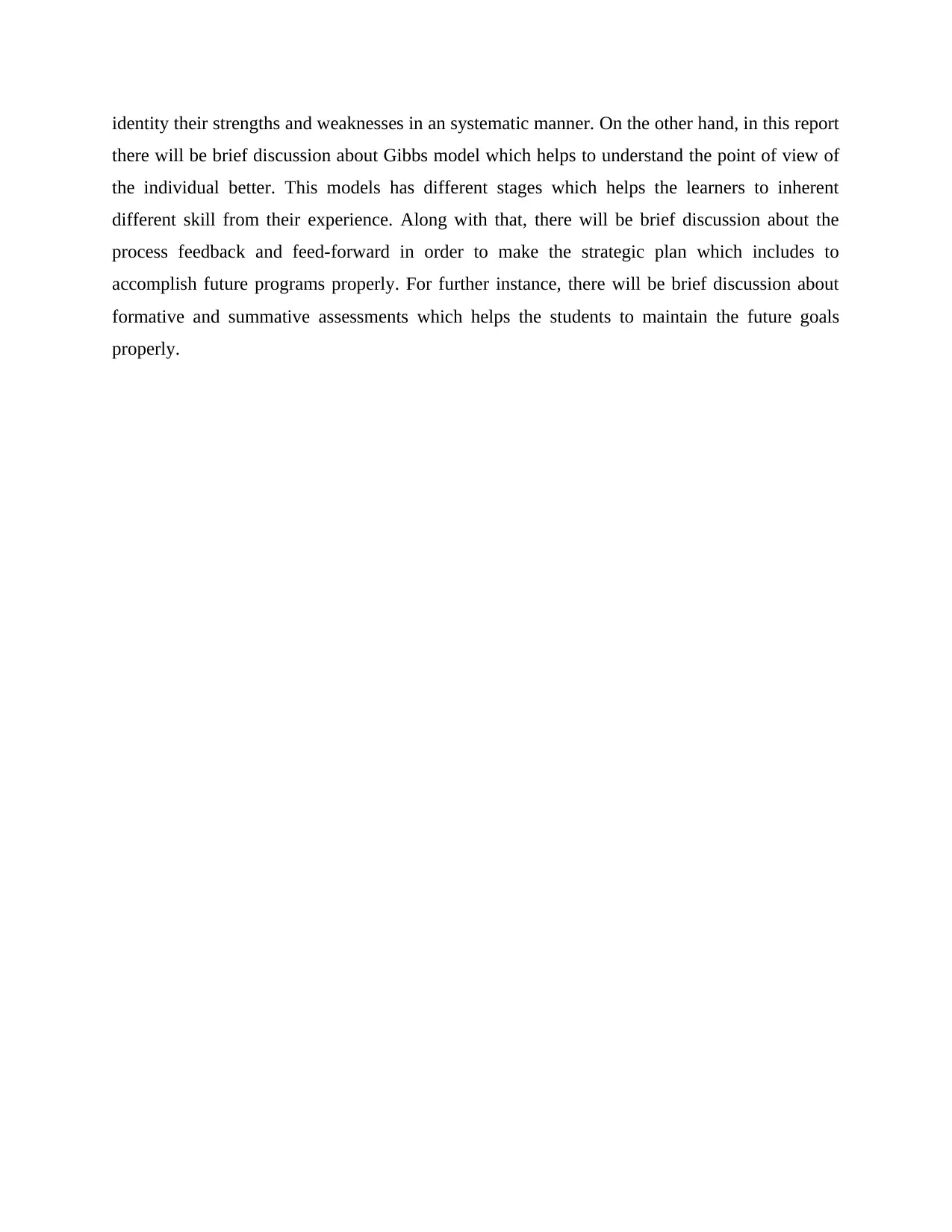
identity their strengths and weaknesses in an systematic manner. On the other hand, in this report
there will be brief discussion about Gibbs model which helps to understand the point of view of
the individual better. This models has different stages which helps the learners to inherent
different skill from their experience. Along with that, there will be brief discussion about the
process feedback and feed-forward in order to make the strategic plan which includes to
accomplish future programs properly. For further instance, there will be brief discussion about
formative and summative assessments which helps the students to maintain the future goals
properly.
there will be brief discussion about Gibbs model which helps to understand the point of view of
the individual better. This models has different stages which helps the learners to inherent
different skill from their experience. Along with that, there will be brief discussion about the
process feedback and feed-forward in order to make the strategic plan which includes to
accomplish future programs properly. For further instance, there will be brief discussion about
formative and summative assessments which helps the students to maintain the future goals
properly.
⊘ This is a preview!⊘
Do you want full access?
Subscribe today to unlock all pages.

Trusted by 1+ million students worldwide
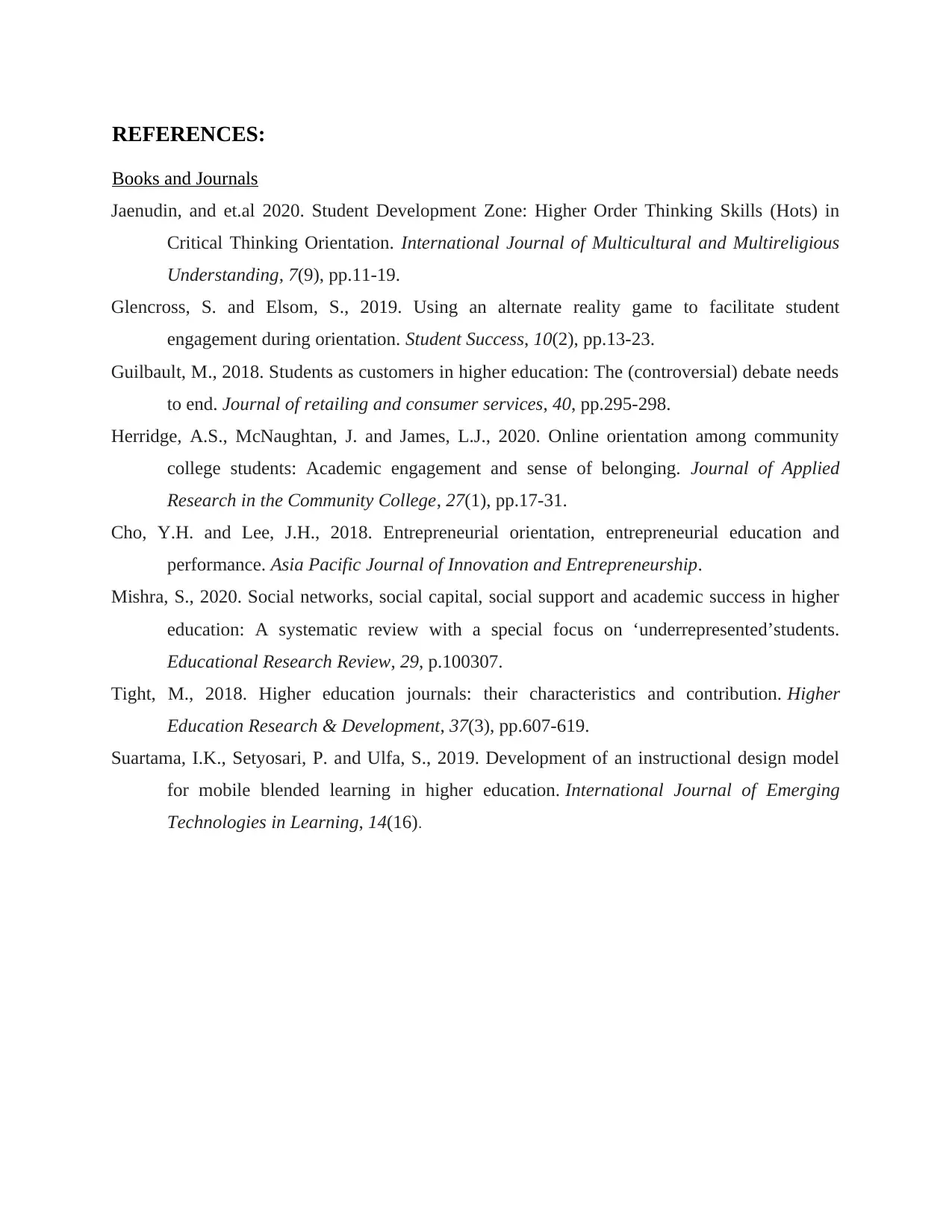
REFERENCES:
Books and Journals
Jaenudin, and et.al 2020. Student Development Zone: Higher Order Thinking Skills (Hots) in
Critical Thinking Orientation. International Journal of Multicultural and Multireligious
Understanding, 7(9), pp.11-19.
Glencross, S. and Elsom, S., 2019. Using an alternate reality game to facilitate student
engagement during orientation. Student Success, 10(2), pp.13-23.
Guilbault, M., 2018. Students as customers in higher education: The (controversial) debate needs
to end. Journal of retailing and consumer services, 40, pp.295-298.
Herridge, A.S., McNaughtan, J. and James, L.J., 2020. Online orientation among community
college students: Academic engagement and sense of belonging. Journal of Applied
Research in the Community College, 27(1), pp.17-31.
Cho, Y.H. and Lee, J.H., 2018. Entrepreneurial orientation, entrepreneurial education and
performance. Asia Pacific Journal of Innovation and Entrepreneurship.
Mishra, S., 2020. Social networks, social capital, social support and academic success in higher
education: A systematic review with a special focus on ‘underrepresented’students.
Educational Research Review, 29, p.100307.
Tight, M., 2018. Higher education journals: their characteristics and contribution. Higher
Education Research & Development, 37(3), pp.607-619.
Suartama, I.K., Setyosari, P. and Ulfa, S., 2019. Development of an instructional design model
for mobile blended learning in higher education. International Journal of Emerging
Technologies in Learning, 14(16).
Books and Journals
Jaenudin, and et.al 2020. Student Development Zone: Higher Order Thinking Skills (Hots) in
Critical Thinking Orientation. International Journal of Multicultural and Multireligious
Understanding, 7(9), pp.11-19.
Glencross, S. and Elsom, S., 2019. Using an alternate reality game to facilitate student
engagement during orientation. Student Success, 10(2), pp.13-23.
Guilbault, M., 2018. Students as customers in higher education: The (controversial) debate needs
to end. Journal of retailing and consumer services, 40, pp.295-298.
Herridge, A.S., McNaughtan, J. and James, L.J., 2020. Online orientation among community
college students: Academic engagement and sense of belonging. Journal of Applied
Research in the Community College, 27(1), pp.17-31.
Cho, Y.H. and Lee, J.H., 2018. Entrepreneurial orientation, entrepreneurial education and
performance. Asia Pacific Journal of Innovation and Entrepreneurship.
Mishra, S., 2020. Social networks, social capital, social support and academic success in higher
education: A systematic review with a special focus on ‘underrepresented’students.
Educational Research Review, 29, p.100307.
Tight, M., 2018. Higher education journals: their characteristics and contribution. Higher
Education Research & Development, 37(3), pp.607-619.
Suartama, I.K., Setyosari, P. and Ulfa, S., 2019. Development of an instructional design model
for mobile blended learning in higher education. International Journal of Emerging
Technologies in Learning, 14(16).
Paraphrase This Document
Need a fresh take? Get an instant paraphrase of this document with our AI Paraphraser

1 out of 8
Related Documents
Your All-in-One AI-Powered Toolkit for Academic Success.
+13062052269
info@desklib.com
Available 24*7 on WhatsApp / Email
![[object Object]](/_next/static/media/star-bottom.7253800d.svg)
Unlock your academic potential
Copyright © 2020–2025 A2Z Services. All Rights Reserved. Developed and managed by ZUCOL.


